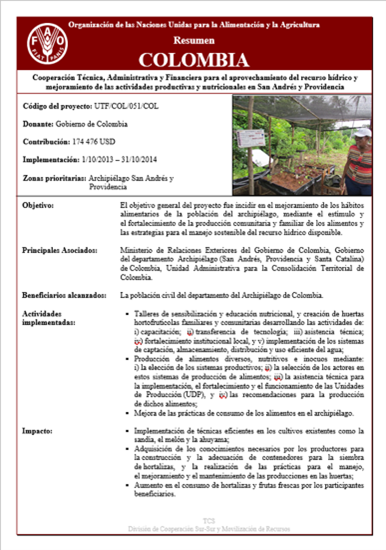Best Practices > Details
Water Catchment, Reserve and Promotion of Rational Use of Water in San Andres and Providencia, Colombia
01/10/2013 , San Andrés

The increase in population in the Colombian archipelago increased the demand for water for human consumption and food production, which could not be met by the existing water sources and the traditional use of the resource. The volume of rainfall in the
area is noticeable but irregular. The lack of water catchment and storage infrastructure prevents the availability of trickling the underground water reserves to meet the demand.
Additionally, the environmental deterioration restricted the water reserves and prevented meeting
the needs of human consumption and farming production to serve the needs of the population, with constant growth rates due to tourism.
To overcome the above challenges, in 2013, FAO implemented a project titled “Technical, administrative
and financial cooperation for the use of water resources and improvement of productive and nutritional activities in San Andres and Providencia”. The project contributed to the improvement of food habits by encouraging and strengthening community
and family production with strategies for water collection, storage and sustainable management.

The project was implemented taking into account previous experiences validated in the Community Demonstration and Training Centres (CDC - Spanish acronym for Centros Demostrativos Comunitarios de Capacitación) in different areas of the country,
through training and awareness-raising workshops on nutritional education that allowed for the creation of family and community vegetable and fruit gardens, the improvement of eating habits through training and technology transfer.
The practice combined agriculture and food activities and was based on experiences of production methods and nutrition improvement validated in different areas of Colombia; therefore, it is always recommended to adjust the training and knowledge
dissemination methods, according to the capacities and characteristics of the potential practice beneficiaries.
It is also increasingly important to highlight the possibility to replicate this remarkable experience by making adjustments
to the characteristics of production and organisation to match other areas. Yet, It is important to bear in mind that activities for the restoration of natural ecosystems (landscape restoration) must be included in the design of the practice to ensure
future sustainability
